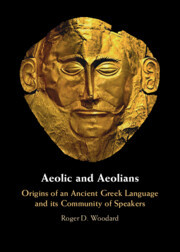Aeolic and Aeolians Origins of an Ancient Greek Language and its Community of Speakers
Langue : Anglais
Auteur : Woodard Roger D.

Aeolic and Aeolians explores the origin of an ancient Greek language and the beginnings and evolution of the community of its speakers ? the Aeolians. Roger Woodard argues that the starting point for both is situated in Asia Minor during the period of the Late Bronze Age, and that the ancestral Aeolic speech community can be identified with the Mycenaean peoples of Anatolia called the Ahhiyawans in Hittite records. These Bronze-Age Asian Greeks would intermarry with local Luvian peoples of western Anatolia, and the Aeolian language and identity ? an identity encoded in myth-emerged from the intermixing of the two societies. Aeolian myths are central to Woodard's ground-breaking investigations presented in this volume. He demonstrates how assemblages of mythic components, what Lévi-Strauss called bricolage, enabled early Aeolians to give intellectual expression to their distinctive Greek identity. With the collapse of Bronze-Age societies in Mycenaean Greece, some of the early Aeolians of Anatolia would migrate to Europe, introducing their language and myths into Hellas.
Introduction; Part I. Aeolian and Aeolic: 1. Archaeology, language, and an Aeolian migration; 2. The Aeolic dialects; 3. More linguistic matters: Aeolic phonology and morphology as language complexification; 4. Mycenaean dialects and Despótēs; 5. Aeolian patronymics and the Mycenaean Hekwetai; 6. Mycenaean Epíkouros; Part II. Aeolian Origins in Myth: 7. Aeolian self-identity and metapontium; 8. Magnesia on the Maeander: Cretans, Aeolians, and a white-horse man; 9. Metapontium: night and day; black and white; 10. Boeotian foundation Mûthoi: from Dioscuri to Cabiri; Part III. Anatolian and Aeolian Myth and Cult: 11. Asian goddesses and bees; 12. Ephesian Artemis' 'breasts' and the Hittite Kurša; 13. Aia and Argonauts; 14. Parnassian divining bee nymphs and lot-divination; 15. Honey and Theogonies: the west face of Sipylus; 16. Bee and bird, Linear B Du-ma/Da-ma, Luvo-Hittite Dammara-, and Artemis/Artimis/Artamis; 17. Conclusion.
Roger D. Woodard is the Andrew van Vranken Raymond Professor of the Classics at the University of Buffalo (The State University of New York). He has held fellowships and visiting appointments at, among other institutions, the Center for Hellenic Studies of Harvard University, the American Academy in Rome, and the University of Oxford. Woodard is author or editor of numerous books, including Divination and Prophecy in the Ancient Greek World (2023, CUP); The Textualization of the Greek Alphabet (2014, CUP); Myth, Ritual, and the Warrior in Roman and Indo-European Antiquity (2013, CUP); The Cambridge Companion to Greek Mythology (2007, CUP). He is series editor of Cambridge's Elements in Greek and Roman Mythology.
Date de parution : 08-2024
Ouvrage de 450 p.
Thème d’Aeolic and Aeolians :
© 2024 LAVOISIER S.A.S.
